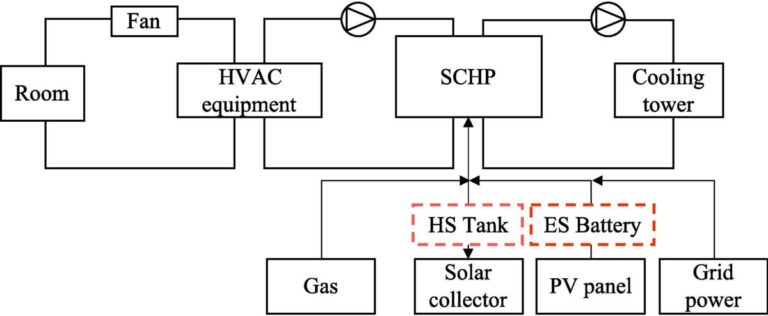The new heat pump concept combines solar energy with chemical storage and reportedly uses 75% less electricity than conventional heat pumps. The system uses a battery and a heat storage tank that can be used separately or simultaneously depending on outdoor conditions.
Researchers from Chiba University in Japan have designed a heat pump system that integrates photovoltaic-thermal (PVT) energy with chemical storage, involving an exothermic reaction that releases heat and an endothermic reaction that stores heat.
The proposed solar chemical heat pump (SCHP) is intended to heat and cool buildings and can reportedly use 75% less electricity than conventional heat pumps, according to its makers. “The introduction of SCHP systems has significant energy, environmental and economic benefits,” the scientists said. “They can improve the energy efficiency of buildings, reduce CO2 emissions and reduce operating costs.”
In the study “Feasibility study with EnergyPlus simulation for chemical solar heat pump unit introduced into building as next generation energy supply system,” published in Energy and Buildingsthe academics explained that a SCHP unit generally combines solar thermal energy with a chemical heat pump sub-unit, adding that PV is used to power the circulating heat transfer fluid to efficiently capture, store and to use.
Their prototype was built with a working pair containing calcium sulfate (CaSO4) and water. It consisted of multiple individual CHP sub-units connected in parallel, with the operational status of each sub-unit configurable in response to the specific load demand.
The SCHP system is also connected to heating, ventilation and air conditioning (HVAC) equipment, a cooling tower and a unit integrating a heat storage tank (HS), solar thermal collectors, PV panels and a battery, as well as a connection to the electricity grid and a gas source. Heat supplied by the solar thermal collectors or the gas source is used for the dehydration reaction aimed at storing heat.
The system can operate in three different modes. In the first case, solar collectors in combination with natural gas provide the thermal energy for the CHP sub-units, PV panels produce power to charge the battery, and the battery provides power for the CHP sub-units, without any use of electricity from the grid .
In the second mode, the PV panels and the electricity grid supply power to the CHP sub-units, solar collectors charge the heat storage tank and the heat storage tank provides thermal energy to the CHP sub-units, without the need for the gas source.
The third mode requires the solar collectors to charge the heat storage tank, and PV panels to generate electricity to charge the battery, with the tank in turn supplying thermal energy to the CHP sub-units, while the battery supplies circulating power to the CHP sub-units , without any form of energy. additional gas or electricity is required.
The group conducted a feasibility study on the system, assuming it would be deployed in a 20-meter-tall research building in Chiba. The battery and the HS tank are dimensioned in such a way that they can meet the energy needs of the building, which has a total area of 8,640 m2.2. “The simulation period runs from January 1 to December 31 and totals 8,760 hours,” the report said. The number of time steps per hour had a maximum value of 60.
The simulation showed that the battery, if used, can help reduce operating costs by 30%, while the HS tank was found to reduce these costs by 82%. “If both are imported, there is no need to consume external energy and annual operating costs approach 0 yen,” the academics pointed out.
The analysis also showed that the SCHP system can consume approximately 75% less electricity than conventional heat pumps, while also contributing to a reduction of CO2 emissions by up to 72%. “The operating costs of the SCHP system in the building are significantly reduced, reducing operating costs by 73%,” the team added. “Compared with the conventional system, the energy consumption in Sapporo, Matsumoto, Tokyo and Kagoshima of the SCHP system has been reduced by 83%, 86%, 80% and 78% respectively. The energy saving effect is better in cold areas than in warm areas.”
The researchers specified that their modeling had some limitation due to the presence of the HVAC system and said future work should consider a more comprehensive economic evaluation. However, they concluded that the proposed system has “tremendous sustainable potential” as a next-generation energy supply system.
This content is copyrighted and may not be reused. If you would like to collaborate with us and reuse some of our content, please contact: editors@pv-magazine.com.


